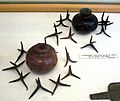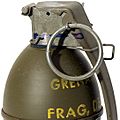Hand grenade facts for kids
A hand grenade is a small explosive device that is thrown at a target. It is a type of weapon used by soldiers. Hand grenades can be used against enemy soldiers or vehicles.
The most common type of grenade is the fragmentation grenade. When it explodes, it sends out many small, fast pieces of metal. These pieces are called fragments. Grenades are usually thrown by hand and explode a few seconds later. Some special grenades can be fired from rifles or special launchers. There are also grenades that contain tear gas. These are used by police to control large crowds or riots.
Soldiers who fight on foot, called infantry, use hand grenades. There are different kinds of grenades for different jobs. Some make a big blast to destroy strong enemy positions like bunkers. Others start fires. And some, like fragmentation grenades, contain shrapnel (sharp metal pieces) to hurt enemy soldiers.
Most grenades look like an egg. They have a metal lever on top with a safety pin and a ring. To use a grenade, you pull out the safety pin. Then, when you throw it, the lever flips up and starts a fuse. You usually have about 5 seconds to throw it and find cover. When the fuse burns out, the grenade explodes. Grenades are very dangerous and can cause serious injuries or even death. It is important to know that you cannot pull a grenade pin with your teeth, and you cannot walk away from an explosion without harm, unlike what you might see in movies or on social media.
What's in a Name?
The word grenade comes from the French word for pomegranate. This is because early grenades looked a bit like the fruit. They were similar in size and shape. The word was first used in English around the 1590s.
A Brief History of Grenades
Early grenades were simple. They were iron balls filled with gunpowder. They had a long fuse that soldiers had to light with a match before throwing. Some of these early grenades were too big to throw. So, soldiers would roll them towards the enemy. Some armies even had special soldiers called "grenadiers." Their main job was to throw or roll these grenades.
In the early 1900s, grenades changed. During World War I, grenades started using time fuses instead of exploding on contact. This meant they would explode after a set amount of time, not just when they hit something. The German army used grenades with handles, called stick grenades, in both World War I and World War II. The Soviet Army used different grenades for attacking and defending.
Related pages
Images for kids
-
Demonstration of a German stielhandgranate (shaft hand grenade), a high explosive grenade with time fuze, the Netherlands, 1946.
-
Hand grenades filled with Greek fire; surrounded by caltrops. (10th–12th centuries National Historical Museum, Athens, Greece)
-
Mongolian grenade attack on Japanese during Yuan dynasty.
-
An illustration of a fragmentation bomb known as the 'divine bone dissolving fire oil bomb' (lan gu huo you shen pao) from the Huolongjing. The black dots represent iron pellets.
-
A cross-section of a Ketchum Grenade, used during the American Civil War.
-
One of the earliest modern hand grenades. Fielded in the British Army from 1908, it was unsuccessful in the trenches of World War I, and was replaced by the Mills bomb.
-
The Mills bomb – the first modern fragmentation grenade – was used in the trenches from 1915
-
An infantryman throwing a hand grenade during training, 1942
-
Grenade on a kepi of the French Army
See also
 In Spanish: Granada de mano para niños
In Spanish: Granada de mano para niños


















